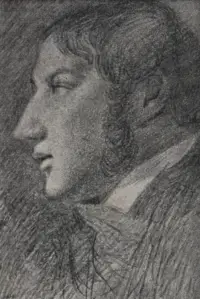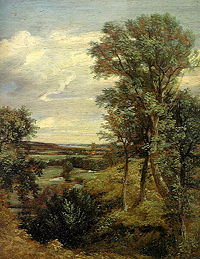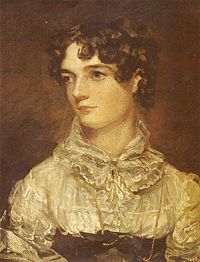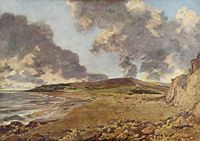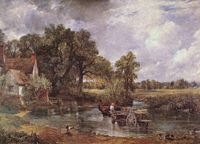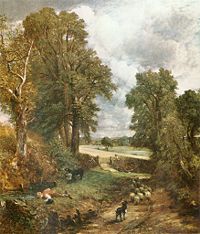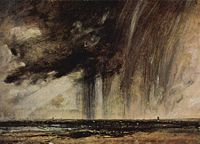John Constable
John Constable (June 11, 1776 – March 31, 1837) was an English Romantic painter. Born in Suffolk, he is known principally for his landscape paintings of Dedham Vale, the area surrounding his home—now known as "Constable Country"—which he invested with an intensity of affection. "I should paint my own places best," he wrote to his friend John Fisher in 1821, "painting is but another word for feeling".[1] Romanticism developed in part as a reaction against the rationalization of nature during the Enlightenment. It stressed strong emotion as a source of aesthetic experience, placing a new emphasis on such emotions as trepidation, horror, and the awe experienced in confronting the sublimity of nature. The Romantic view of nature expresses a longing for a return to a state of greater oneness with the creation, from which modern life has become more separated.
Constable's most famous paintings include Dedham Vale of 1802 and The Hay Wain of 1821. Although his paintings are now among the most popular and valuable in British art, he was never financially successful and did not become a member of the establishment until he was elected to the Royal Academy at the age of 43. Although comparatively ignored in England, Constable remained true to his chosen expression. He was more widely appreciated outside his native land and sold more paintings in France than England.
Early career
John Constable was born in East Bergholt, a village on the River Stour in Suffolk, to Golding and Ann Constable. His father was a wealthy corn merchant, owner of Flatford Mill and, later, Dedham Mill. Although Constable was his parents' second son, his older brother was mentally handicapped and so John was expected to succeed his father in the business. He worked at the corn business after leaving school, but his younger brother Abram eventually took over the running of the mills.
In his youth, Constable embarked on amateur sketching trips in the surrounding Suffolk countryside that was to become the subject of a large proportion of his art. These scenes, in his own words, "made me a painter, and I am grateful"; "the sound of water escaping from mill dams etc., willows, old rotten planks, slimy posts, and brickwork, I love such things."[2] He was introduced to George Beaumont, a collector, who showed him his prized Hagar and the Angel by Claude Lorrain, which inspired Constable. Later, while visiting relatives in Middlesex, he was introduced to the professional artist John Thomas Smith, who advised him on painting but also urged him to remain in his father's business rather than take up art professionally.
In 1799, Constable persuaded his father to let him pursue art, and Golding even granted him a small allowance. Entering the Royal Academy Schools as a probationer, he attended life classes and anatomical dissections as well as studying and copying Old Masters. Among works that particularly inspired him during this period were paintings by Thomas Gainsborough, Claude Lorrain, Peter Paul Rubens, Annibale Carracci and Jacob van Ruisdael. He also read widely among poetry and sermons, and later proved a notably articulate artist. By 1803, he was exhibiting paintings at the Royal Academy.
In 1802 he refused the position of drawing master at Great Marlow Military College, a move which Benjamin West (then master of the RA) counselled would mean the end of his career. In that year, Constable wrote a letter to John Dunthorne in which he spelled out his determination to become a professional landscape painter:
For the last two years I have been running after pictures, and seeking the truth at second hand. I have not endeavoured to represent nature with the same elevation of mind with which I set out, but have rather tried to make my performances look like the work of other men…There is room enough for a natural painter. The great vice of the present day is bravura, an attempt to do something beyond the truth.[3]
His early style has many of the qualities associated with his mature work, including a freshness of light, color and touch, and reveals the compositional influence of the Old Masters he had studied, notably of Claude Lorrain.[4] Constable's usual subjects, scenes of ordinary daily life, were unfashionable in an age that looked for more romantic visions of wild landscapes and ruins, though he did make occasional trips further afield; for example, in 1803 he spent almost a month aboard the East Indiaman ship Coutts as it visited south-east coastal ports, and in 1806 he undertook a two-month tour of the Lake District.[5] But he told his friend and biographer Charles Leslie that the solitude of the mountains oppressed his spirits; Leslie went on to write:
His nature was peculiarly social and could not feel satisfied with scenery, however grand in itself, that did not abound in human associations. He required villages, churches, farmhouses and cottages.[6]
In order to make ends meet, Constable took up portraiture, which he found dull work—though he executed many fine portraits. He also painted occasional religious pictures, but according to John Walker, "Constable's incapacity as a religious painter cannot be overstated."[7]
Constable adopted a routine of spending the winter in London and painting at East Bergholt in the summer. And in 1811 he first visited John Fisher and his family in Salisbury, a city whose cathedral and surrounding landscape were to inspire some of his greatest paintings.
Marriage and maturity
From 1809 onwards, his childhood friendship with Maria Bicknell developed into a deep, mutual love. But their engagement in 1816 was opposed by Maria's grandfather, Dr Rhudde, rector of East Bergholt, who considered the Constables his social inferiors and threatened Maria with disinheritance.
Maria's father, Charles Bicknell, a solicitor, was reluctant to see Maria throw away this inheritance, and Maria herself pointed out that a penniless marriage would detract from any chances John had of making a career in painting.
Golding and Ann Constable, while approving the match, held out no prospect of supporting the marriage until Constable was financially secure; but they died in quick succession, and Constable inherited a fifth share in the family business.
John and Maria's marriage in October 1816 was followed by a honeymoon tour of the south coast, where the sea at Weymouth and Brighton stimulated Constable to develop new techniques of brilliant color and vivacious brushwork. At the same time, a greater emotional range began to register in his art.[8]
Although he had scraped an income from painting, it was not until 1819 that Constable sold his first important canvas, The White Horse, which led to a series of "six footers," as he called his large-scale paintings.
He was elected an Associate of the Royal Academy that year, and in 1821 he showed The Hay Wain (a view from Flatford Mill) at the Academy's exhibition. Théodore Géricault saw it on a visit to London and was soon praising Constable in Paris, where a dealer, John Arrowsmith, bought four paintings, including The Hay Wain, which was exhibited at the Paris Salon of 1824, winning a gold medal.
Of Constable's color, Delacroix wrote in his journal: "What he says here about the green of his meadows can be applied to every tone".[9] Delacroix repainted the background of his 1824 Massacre de Scio after seeing the Constables at Arrowsmith's Gallery, which he said had done him a great deal of good.[10]
In his lifetime Constable was to sell only 20 paintings in England, but in France he sold more than 20 in just a few years. Despite this, he refused all invitations to travel internationally to promote his work, writing to Francis Darby: "I would rather be a poor man [in England] than a rich man abroad."[11]
In 1825, perhaps due partly to the worry of his wife's ill-health, the uncongeniality of living in Brighton ("Piccadilly by the Seaside"[12]), and the pressure of numerous outstanding commissions, he quarrelled with Arrowsmith and lost his French outlet.
After the birth of her seventh child in January 1828, Maria fell ill and died of tuberculosis that November at the age of 41. Intensely saddened, Constable wrote to his brother Golding, "hourly do I feel the loss of my departed Angel—God only knows how my children will be brought up…the face of the World is totally changed to me".[13]
Thereafter, he always dressed in black and was, according to Leslie, "a prey to melancholy and anxious thoughts." He cared for his seven children alone for the rest of his life.
Shortly before her death, Maria's father had died, leaving her £20,000. Constable speculated disastrously with this money, paying for the engraving of several mezzotints of some of his landscapes in preparation for a publication. He was hesitant and indecisive, nearly fell out with his engraver, and when the folios were published, could not interest enough subscribers.
He was elected to the Royal Academy in February 1829, at the age of 52, and in 1831 was appointed Visitor at the Royal Academy, where he seems to have been popular with the students.
He also began to deliver public lectures on the history of landscape painting, which were attended by distinguished audiences. In a series of such lectures at the Royal Institution, Constable proposed a threefold thesis: firstly, landscape painting is scientific as well as poetic; secondly, the imagination cannot alone produce art to bear comparison with reality; and thirdly, no great painter was ever self-taught.
He also later spoke against the new Gothic Revival movement, which he considered mere "imitation."
In 1835, his last lecture to the students of the RA, in which he praised Raphael and called the R.A. the "cradle of British art," was "cheered most heartily".[14]He died on the night of the 31st March, apparently from indigestion.
Art
Constable quietly rebelled against the artistic culture that taught artists to use their imagination to compose their pictures rather than nature itself. He told Leslie, "When I sit down to make a sketch from nature, the first thing I try to do is to forget that I have ever seen a picture."[15]
Although Constable produced paintings throughout his life for the "finished" picture market of patrons and R.A. exhibitions, constant refreshment in the form of on-the-spot studies was essential to his working method, and he never satisfied himself with following a formula. "The world is wide," he wrote, "no two days are alike, nor even two hours; neither were there ever two leaves of a tree alike since the creation of all the world; and the genuine productions of art, like those of nature, are all distinct from each other."[16]
Constable painted many full-scale preliminary sketches of his landscapes in order to test the composition in advance of finished pictures. These large sketches, with their free and vigorous brushwork, were revolutionary at the time, and they continue to interest artists, scholars and the general public. The oil sketches of The Leaping Horse and The Hay Wain, for example, convey a vigour and expressiveness missing from Constable's finished paintings of the same subjects. Possibly more than any other aspect of Constable's work, the oil sketches reveal him in retrospect to have been an avant-garde painter, one who demonstrated that landscape painting could be taken in a totally new direction.
Constable's watercolors were also remarkably free for their time: the almost mystical Stonehenge, 1835, with its double rainbow, is one of the greatest watercolors ever painted.[17]When he exhibited it in 1836, Constable appended a text to the title: "The mysterious monument of Stonehenge, standing remote on a bare and boundless heath, as much unconnected with the events of past ages as it is with the uses of the present, carries you back beyond all historical records into the obscurity of a totally unknown period."[18]
In addition to the full-scale oil sketches, Constable completed numerous observational studies of landscapes and clouds, determined to become more scientific in his recording of atmospheric conditions. The power of his physical effects was sometimes apparent even in the full-scale paintings which he exhibited in London; The Chain Pier, 1827, for example, prompted a critic to write: "the atmosphere possesses a characteristic humidity about it, that almost imparts the wish for an umbrella".[19]
The sketches themselves were the first ever done in oils directly from the subject in the open air. To convey the effects of light and movement, Constable used broken brushstrokes, often in small touches, which he scumbled over lighter passages, creating an impression of sparkling light enveloping the entire landscape. One of the most expressionistic and powerful of all his studies is Seascape Study with Rain Cloud, painted in around 1824 at Brighton, which captures with slashing dark brushstrokes the immediacy of an exploding cumulus shower at sea.[20] Constable also became interested in painting rainbow effects, for example in Salisbury Cathedral from the Meadows, 1831, and in Cottage at East Bergholt, 1833.
To the sky studies he added notes, often on the back of the sketches, of the prevailing weather conditions, direction of light, and time of day, believing that the sky was "the key note, the standard of scale, and the chief organ of sentiment" in a landscape painting.[21] In this habit he is known to have been influenced by the pioneering work of the meteorologist Luke Howard on the classification of clouds; Constable's annotations of his own copy of Researches About Atmospheric Phaenomena by Thomas Forster show him to have been fully abreast of meteorological terminology.[22] "I have done a good deal of skying," Constable wrote to Fisher on 23 October 1821; "I am determined to conquer all difficulties, and that most arduous one among the rest".[23]
Legacy
Constable once wrote in a letter to Leslie, "My limited and abstracted art is to be found under every hedge, and in every lane, and therefore nobody thinks it worth picking up".[24] He could never have imagined how influential his honest techniques would turn out to be. Constable's art inspired not only contemporaries like Géricault and Eugene Delacroix, but the Barbizon School, and the French impressionists of the late nineteenth century.
Constable collaborated closely with the talented mezzotinter David Lucas on some 40 prints after his landscapes, one of which went through 13 proof stages, corrected by Constable in pencil and paint. Constable said "Lucas showed me to the public without my faults," but the venture was not a financial success.[25]
Paintings
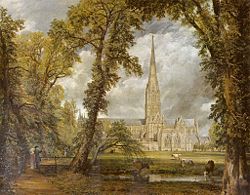
- Dedham Vale, 1802.
- The Hay Wain, 1821.
- Salisbury Cathedral, 1825.
- The Cornfield, 1826.
- Salisbury Cathedral from the Meadows, 1829.
- Brighton Beach with Colliers, 1824.
- Boat-building near Flatford Mill, 1815.
- Study of Cirrus Clouds, c. 1822.
Constable locations
Bridge Cottage, is a National Trust property, open to the public. Nearby Flatford Mill and Willie Lott's cottage (the house visible in The Hay Wain) are used by the Field Studies Council for art courses.
Notes
- ↑ Ronald Parkinson. John Constable, the Man and his Art. (London, V&A Publications, 1998, ISBN 185177243X), 9.
- ↑ Parkinson, John Constable, 15.
- ↑ John E. Thornes. John Constable's Skies. (The University of Birmingham Press, 1999, ISBN 1902459024), 96.
- ↑ Parkinson, John Constable, 17.
- ↑ Parkinson, John Constable, 18.
- ↑ Parkinson, John Constable, 22.
- ↑ John Walker. Constable. (London, Thames and Hudson, 1979, ISBN 0500091331)
- ↑ Parkinson, John Constable, 24.
- ↑ Diane Kelder. The Great Book of French Impressionism. (Abbeville Press, 1980, ISBN 0896591514), 27.
- ↑ Parkinson, John Constable, 132.
- ↑ Walker, Constable
- ↑ Thornes, John Constable's Skies, 128.
- ↑ Parkinson, John Constable, 33.
- ↑ Parkinson, John Constable, 50.
- ↑ Thornes, John Constable's Skies, 51.
- ↑ Parkinson, John Constable, 64.
- ↑ Parkinson, John Constable, 73.
- ↑ Parkinson, John Constable, 89.
- ↑ Parkinson, John Constable, 102.
- ↑ Thornes, John Constable's Skies, 128.
- ↑ Parkinson, John Constable, 110.
- ↑ Thornes, John Constable's Skies, 68.
- ↑ Thornes, John Constable's Skies, 56.
- ↑ Parkinson, John Constable, 129.
- ↑ A. Hyatt Mayor. Prints and People. Metropolitan Museum of Art. (Princeton, 1971, nos 455-460. ISBN 0691003262)
ReferencesISBN links support NWE through referral fees
- Fraser, John Lloyd. John Constable 1776~1837. Hutchinson & Co., 1976. ISBN 9780091255404
- Kelder, Diane. The Great Book of French Impressionism. New York: Abbeville Press, 1980, ISBN 0896591514
- Leslie, C.R. (1995 edition). Memoirs of the Life of John Constable: Composed Chiefly of His Letters. Phaidon, ISBN 0714833606
- Mayor, A. Hyatt. Prints and People. Metropolitan Museum of Art. Princeton, 1971, nos 455-460. ISBN 0691003262
- Parkinson, Ronald. John Constable, the Man and his Art. London, V&A Publications, 1998, ISBN 185177243X
- Thornes, John E. John Constable's Skies. The University of Birmingham Press, 1999, ISBN 1902459024
- Walker, John. Constable. London: Thames and Hudson, 1979. ISBN 0500091331
External links
All links retrieved January 30, 2025.
- John Constable at Olga's Gallery
- Biography at Webmuseum, Paris
- John Constable at Find-A-Grave
- Constable: The Great Landscapes (Tate Britain 2006): an illustrated review
| Romanticism | |
|---|---|
| Eighteenth century - Nineteenth century | |
| Romantic music: Beethoven - Berlioz - Brahms - Chopin - Grieg - Liszt - Puccini - Schumann - Tchaikovsky - The Five - Verdi - Wagner | |
| Romantic poetry: Blake - Burns - Byron - Coleridge - Goethe - Hölderlin - Hugo - Keats - Lamartine - Leopardi - Lermontov - Mickiewicz - Nerval - Novalis - Pushkin - Shelley - Słowacki - Wordsworth | |
| Visual art and architecture: Brullov - Constable - Corot - Delacroix - Friedrich - Géricault - Gothic Revival architecture - Goya - Hudson River school - Leutze - Nazarene movement - Palmer - Turner | |
| Romantic culture: Bohemianism - Romantic nationalism | |
| << Age of Enlightenment | Victorianism >> Realism >> |
Credits
New World Encyclopedia writers and editors rewrote and completed the Wikipedia article in accordance with New World Encyclopedia standards. This article abides by terms of the Creative Commons CC-by-sa 3.0 License (CC-by-sa), which may be used and disseminated with proper attribution. Credit is due under the terms of this license that can reference both the New World Encyclopedia contributors and the selfless volunteer contributors of the Wikimedia Foundation. To cite this article click here for a list of acceptable citing formats.The history of earlier contributions by wikipedians is accessible to researchers here:
The history of this article since it was imported to New World Encyclopedia:
Note: Some restrictions may apply to use of individual images which are separately licensed.
